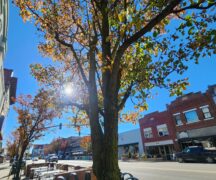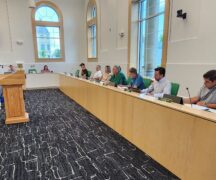By JAN LARSON McLAUGHLIN
BG Independent News
Some of the majestic maples that adorned the historic strip of West Wooster Street went on the chopping block recently to enable the city to update aging utilities.
The loss of the trees caused alarm for some members of the city’s tree commission. But Bowling Green Public Services Director Joe Fawcett said the city made efforts to limit the loss.
“The city works extremely hard to minimize the removal of trees and I believe this project demonstrates that,” Fawcett said. “I hate to remove trees like others, but unfortunately there are instances where the city really has no other choice.”
Fawcett said the West Wooster project involves much needed utility upgrades including new water and sewer lines and the associated service connections to residences and businesses along the route. The upgrades are necessary due to the age and condition of the infrastructure, and increased calls for service and breaks.
Originally it appeared that 20 street trees in the right-of-way would need to be cut down to make way for the utility upgrades, Fawcett said.
However, the city’s arborist, engineering and utilities staff worked together to modify the original plans so that eight of the 20 trees would be salvaged.
“We are purposely making adjustments to the plan to save trees,” Fawcett said.
Of the dozen trees on the chopping block, two had outgrown the space they were in and would have had to be removed anyway, and two others were identified as being in decline and likely would have had to be removed in the near future, according to Fawcett.
“The city certainly does not aim to remove trees,” he said. “We are a ‘Tree City’ for a reason. We value trees.”
And city officials also know that residents love their trees and often have difficulty parting with them.
“Public works and the arborist have been communicating with the residents,” Fawcett said.
The city’s new arborist, Adrien Lowien-Kirian, is working to identify replacement trees that are species better suited to lining streets. The tree selections will take into consideration environmental conditions like the proximity to the street, the utilities under their roots and the wires above their branches.
“We want to be putting the right tree in the right spot,” Lowien-Kirian said.
In the past, silver maples were often planted in right-of-ways since they are fast-growing trees.
“A lot of the trees were way too big for those areas,” Lowien-Kirian said. “Those are backyard trees – not boulevard trees.”
So instead, the city will be planting trees with smaller canopies that are less likely to intrude on overhead wires, and smaller root systems so they are less likely to cause problems with underground utilities.
Some examples of possible street trees as replacements on West Wooster include different types of maples, flowering dogwoods, redbuds, some types of buckeyes and serviceberry trees.
By making better choices in the future, the city can avoid chopping down trees for utility projects, Lowien-Kirian said.
“We never want to cut down trees just to do it,” she said.





